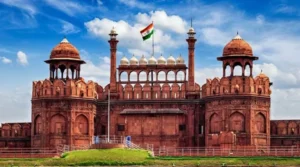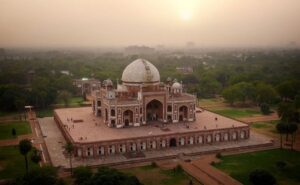Discover the History of Delhi as the Capital
There are numerous cities that have served as India’s capital over the years. There have even been instances when a country had more than one capital or a summer and a winter capital. However, Delhi continues to be the capital of India.
A metropolis that is nothing more than the product of the intersection of its 17 million residents, where cultural heritage and the newest inventions coexist in streets brimming with activity. Additionally, Delhi is India’s second-most populous metropolis after Mumbai.
India’s current capital

Contrary to popular assumption, Delhi has had an explosive growth in the number of new technology startups in recent years, particularly those focused on SaaS. (Software as a Service). For two key reasons—a big number of English-speaking developers and a generally inexpensive recruiting cost—many international investors have already chosen to invest in technology development in this and other cities in India. India has now experienced economic development that is unprecedented.
Technological advancements are good news for Delhi and India as a whole. But without its past, this city would neither have that future nor be what it is now. Leaving Their Mark: A Rich Cultural Heritage from Times Gone By. Delhi is one of the oldest cities in the world, which has led to people who are unfamiliar with it being shocked by monuments that seem to have materialised out of thin air among the maze-like complexes of contemporary structures. After passing an apartment complex, you are suddenly in front of a sizable esplanade where the Gateway of India is located.
Old capitals of India
There is a vast number of cities that have held the title of capital of India at various points in history. While we are unable to cover them all because doing so would need writing a whole book, we will take a brief tour “flying over” the various capital changes.
The Nanda dynasty, the Maurya, Gupta, and Pala empires all had their capitals in Ancient Pataliputra, which is now simply a collection of ruins and part of the site of Patna. The legend has it that Gautama Buddha founded it and resided there in the fifth century BC.

Around the first and third century AD, the Kushan empire descended, raiding Pataliputra and establishing Begram (in Afghanistan) as India’s summer capital and Mathura as its winter capital.
Pratishthnapura was once again the capital of India starting in 230 AD, during the Satavjana empire (now simply called Paithan).
The Pushyabhuti dynasty (6th–7th century) and the Pratiharas empire (8th–11th century) both picked Kannauj as its capital, which is located in the northern section of the subcontinent.
The Rashtrakuta dynasty established Manyakheta as the capital of India in the southern region between the 6th and 10th centuries; however, when the Pratihara empire arrived in that region, the name was changed to Avanti.
The capital and administrative hub of the Gupta dynasty (4th to 6th centuries AD) was the city of Ghazipur under the rule of Gaadhi and Vishwamitra.
The city of Gangaikonda Cholapuram was picked at the height of the Chola empire (about 1025).
Together with Pataliputra, Gaur was once among the world’s most populated cities and served as the capital of the Pala dynasty (7th to 13th centuries).
From I BC to the end of IV AD, the nomadic Saka peoples also had their own capitals, the first of which was Sigal, followed by Taxila and, subsequently, Mathura.
The Indo-Greeks selected the city of Sakala as their location between the second century BC and the first century AD in the northern and western regions of the Indian subcontinent.
During the medieval period
Delhi has held the title of Indian capital more times than just now. This city served as the Delhi Sultanate’s administrative centre between the years of 1206 and 1526. Muhammad bin Tughluq, the monarch of the Tughlaq dynasty of the sultanate, ordered the people of Delhi to relocate to Daulatabad in 1327. However, it was only used as a capital for two years until it was abandoned because of a water shortage.
Between the 12th and 13th centuries, the Iltutmish empire had its capital at Badaun, while the Ghurid sultanate had its capital at Ghor (Afghanistan).
Vijayanagara existed under the rule of Akbar from 1571 until 1585.
It served as the Vijayanagara Empire’s capital. It is thought that it was abandoned, similar to Daulatabad.
Murshid Quli Khan, the first Nawab of Bengal (the title for the ruler of the Bengal Subah, a province of the Mughal Empire), moved the capital from Dhaka to Mukshudabad in 1704, renaming it Murshidabad, which translates to “the city of Murshid Quli Khan.”
The Peshwa (chief minister) office of the Maratha empire (17th to 19th century) was relocated to Pune in 1730.
Later in 1763, Murshidabad was replaced with Munger as the capital by the Nawab of Bengal, Mir Qasim Ali.
In the modern period
From 1858, when the British Raj (colonial government of the British Crown) first began, until 1911, when the partition of Bengal was revoked, Calcutta served as the country’s capital. This event was revealed on December 12 of that year at the Delhi Durbar, a formal celebration in which Delhi was designated as the new capital and King George V was crowned Emperor of India. Shimla, which was designated the Raj’s summer capital in 1864, shared the distinction with those two capitals during the British India era.
After India gained independence in 1947, Delhi kept the title, but Shimla became the state capital of Himachal Pradesh.
And thus, this turbulent historical and topographical tour of India comes to a conclusion.
Would you like to travel to India and explore some of the cities that are still there and were formerly designated as the capital?
